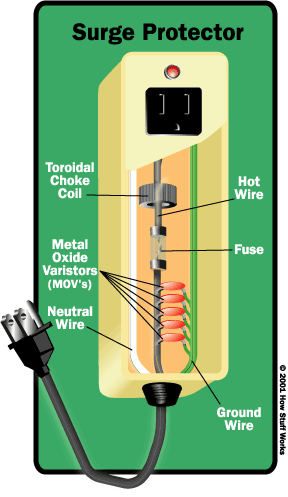Library Contents Search the Library RV Tech Library Help Page Site Map About Us Tiffin RV Network TRVN Classifieds Campground Reviews Photo Gallery TRVN Store
Appliances Batteries Boondocking/Dry Camping Chassis Clubs & Forums Electrical Electronics Engines Exterior Maintenance Generators Heating & Air Conditioning Interior Maintenance Misc Items Operating Tips Plumbing Red Bay Safety & Health Storage Supplier Contacts Tires and Wheel Rims Towing Transmissions Weighing

Computer Surge Protection
When you put together a computer system, one piece of standard equipment you'll probably need is a surge protector. Most designs serve one immediately obvious function -- they let you plug multiple components into one power outlet. With all of the different components that make up a computer system, this is definitely a useful device.
But the other function of a surge protector power strip -- protecting the electronics in your computer from surges in power -- is far more important. We will try to explain surge protectors, also called surge suppressors, to find out what they do, when you need them, and how well they work. We'll also find out what levels of protection are available and see why you might not have all the protection you need, even if you do use a quality surge protector.
Surge Protector Basics - The main job of a surge protector system is to protect electronic devices from "surges." So if you're wondering what a surge protector does, the first question is, "What are surges?" And then, "Why do electronics need to be protected from them?"
A power surge, or transient voltage, is an increase in voltage significantly above the designated level in a flow of electricity. In normal household and office wiring in the United States, the standard voltage is 120 volts. If the voltage rises above 120 volts, there is a problem, and a surge protector helps to prevent that problem from destroying your computer.
To understand the problem, it is helpful to understand something about voltage. Voltage is a measure of a difference in electric potential energy. Electric current travels from point to point because there is a greater electric potential energy on one end of the wire than there is on the other end. This is the same sort of principle that makes water under pressure flow out of a hose -- higher pressure on one end of the hose pushes water toward an area of lower pressure. You can think of voltage as a measure of electrical pressure.
As we'll see later on, various factors can cause a brief increase in voltage.
-
When the increase lasts three nanoseconds (billionths of a second) or more, it's called a surge.
-
When it only lasts for one or two nanoseconds, it's called a spike.
If the surge or spike is high enough, it can inflict some heavy damage on a machine. The effect is very similar to applying too much water pressure to a hose. If there is too much water pressure, a hose will burst. Approximately the same thing happens when too much electrical pressure runs through a wire -- the wire "bursts." Actually, it heats up like the filament in a light bulb and burns, but it's the same idea. Even if increased voltage doesn't immediately break your machine, it may put extra strain on the components, wearing them down over time. In the next section, we'll look at what surge protectors do to prevent this from happening.
A number of older RV parks are succeptable to power surges because of their basic original wiring design. When they were built, no one every gave it a thought that an RV would require 50 amps of service and have all of the electronic equipment that today's Tiffin Motorhome comes equipped with.
The Process of Protection
A standard surge protector passes the electrical current along from the outlet to a number of electrical and electronic devices plugged into the power strip. If the voltage from the outlet surges or spikes -- rises above the accepted level -- the surge protector diverts the extra electricity into the outlet's grounding wire.
In the most common type of surge protector, a component called a metal oxide varistor, or MOV, diverts the extra voltage. As you can see in the diagram below, an MOV forms a connection between the hot power line and the grounding line.
An MOV has three parts: a piece of metal oxide material in the middle, joined to the power and grounding line by two semiconductors.
These semiconductors have a variable resistance that is dependent on voltage. When voltage is below a certain level, the electrons in the semiconductors flow in such a way as to create a very high resistance. When the voltage exceeds that level, the electrons behave differently, creating a much lower resistance. When the voltage is correct, an MOV does nothing. When voltage is too high, an MOV can conduct a lot of current to eliminate the extra voltage.

As soon as the extra current is diverted into the MOV and to ground, the voltage in the hot line returns to a normal level, so the MOV's resistance shoots up again. In this way, the MOV only diverts the surge current, while allowing the standard current to continue powering whatever machines are connected to the surge protector. Metaphorically speaking, the MOV acts as a pressure-sensitive valve that only opens when there is too much pressure. Thus, saving your expensive computer equipment from severe damage.
Submitted by Mike Sundberg - 3/11/06
Click Your browser's "Back" button to return to the previous page
or chose another category from the side menu.
The RV Tech Library is brought to you by the TiffinRVnetwork
Absolutely No Affiliation exists between this group and Tiffin Motor Homes Inc or the Allegro Club. This website neither endorses or discourages the use or purchase of a Tiffin product. All references, suggestions, comments, etc. contained herein are the opinions/experiences of the posters and not those of Tiffin Motor Homes Inc. or the website administrators.



